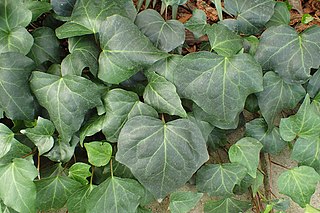
Hedera, commonly called ivy, is a genus of 12–15 species of evergreen climbing or ground-creeping woody plants in the family Araliaceae, native to Western Europe, Central Europe, Southern Europe, Macaronesia, northwestern Africa and across central-southern Asia east to Japan and Taiwan. Several species are cultivated as climbing ornamentals, and the name ivy especially denotes common ivy, known in North America as "English ivy", which is frequently planted to clothe brick walls.
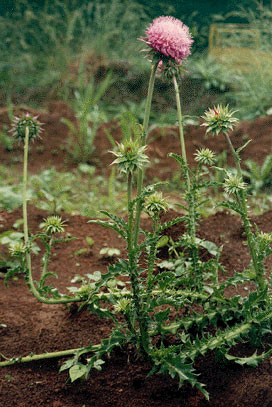
Carduus nutans is a biennial plant in the daisy and sunflower family Asteraceae with the common names musk thistle, nodding thistle, and nodding plumeless thistle. It is native to regions of Europe, Central Asia, and North Africa, where it is a scattered pasture plant. The musk thistle has been declared as invasive in North America, Australia, New Zealand, and South Africa.

Onopordum acanthium is a flowering plant in the family Asteraceae. It is native to Europe and Western Asia from the Iberian Peninsula east to Kazakhstan, and north to central Scandinavia, and widely naturalised elsewhere, with especially large populations present in the United States and Australia. It is a vigorous biennial plant with coarse, spiny leaves and conspicuous spiny-winged stems.
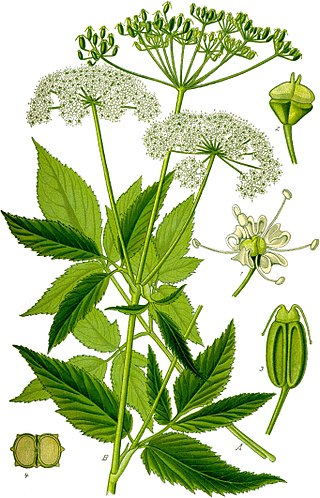
Aegopodium podagraria, commonly called ground elder, is a species of flowering plant in the carrot family Apiaceae that grows in shady places. The name "ground elder" comes from the superficial similarity of its leaves and flowers to those of elder (Sambucus), which is not closely related. Other common names include herb gerard, bishop's weed, goutweed, gout wort, snow-in-the-mountain, English masterwort and wild masterwort. It is the type species of the genus Aegopodium. It is native to Europe and Asia, but has been introduced around the world as an ornamental plant, where it occasionally poses an ecological threat as an invasive exotic plant.

Leucanthemum vulgare, commonly known as the ox-eye daisy, oxeye daisy, dog daisy, marguerite and other common names, is a widespread flowering plant native to Europe and the temperate regions of Asia, and an introduced plant to North America, Australia and New Zealand.
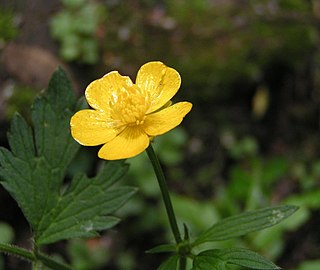
Ranunculus repens, the creeping buttercup, is a flowering plant in the buttercup family Ranunculaceae, native to Europe, Asia and northwestern Africa. It is also called creeping crowfoot and sitfast.

Sanguisorba minor, the salad burnet, garden burnet, small burnet, burnet, pimpernelle, Toper's plant, and burnet-bloodwort, is an edible perennial herbaceous plant in the family Rosaceae. It has ferny, toothed-leaf foliage; the unusual crimson, spherical flower clusters rise well above the leaves on thin stems. It generally grows to 25–55 cm tall. The large, long, taproots store water, making it drought-tolerant.

Arctotheca calendula is a plant in the sunflower family commonly known as capeweed, plain treasureflower, cape dandelion, or cape marigold because it occurs in the Western Cape Province in South Africa. It has a wide distribution in coastal areas of South Africa, extending from Namaqualand to Cape Point and as far as KwaZulu-Natal.

Sphagneticola trilobata, commonly known as the Bay Biscayne creeping-oxeye, merigold Singapore daisy, creeping-oxeye, trailing daisy, and wedelia, is a plant in the tribe Heliantheae of the family Asteraceae. It is native to Mexico, Central America, and the Caribbean, but now grows throughout the Neotropics. It is widely cultivated as an ornamental groundcover.
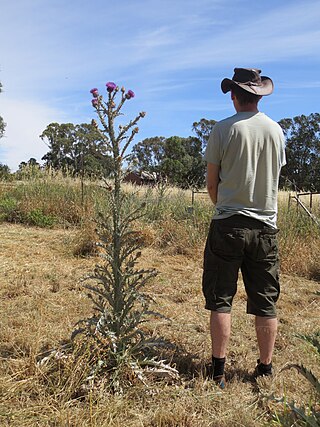
A noxious weed, harmful weed or injurious weed is a weed that has been designated by an agricultural or other governing authority as a plant that is harmful to agricultural or horticultural crops, natural habitats or ecosystems, or humans or livestock. Most noxious weeds have been introduced into an ecosystem by ignorance, mismanagement, or accident. Some noxious weeds are native, though many localities define them as necessarily being non-native. Typically they are plants that grow aggressively, multiply quickly without natural controls, and display adverse effects through contact or ingestion. Noxious weeds are a large problem in many parts of the world, greatly affecting areas of agriculture, forest management, nature reserves, parks and other open space.
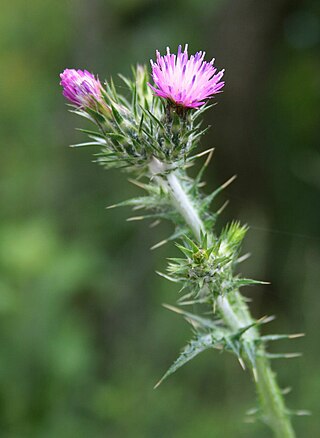
Carduus pycnocephalus, with common names including Italian thistle, Italian plumeless thistle, and Plymouth thistle, is a species of thistle. It is native to the Mediterranean region in southern Europe, North Africa, and Western Asia; Eastern Europe and the Caucasus; and the Indian Subcontinent.
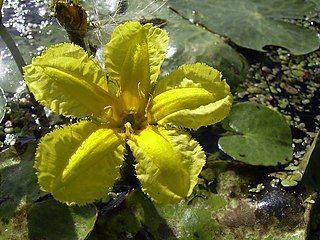
Nymphoides peltata is perennial, rooted aquatic plant with floating leaves of the family Menyanthaceae.
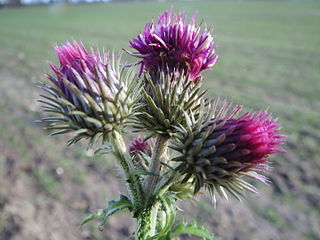
Carduus acanthoides, known as the spiny plumeless thistle, welted thistle, or plumeless thistle, is a biennial plant species of thistle in the family Asteraceae. The plant is native to Europe and Asia and introduced in many other areas, where it is sometimes considered an invasive species.

Senecio angulatus, also known as creeping groundsel and Cape ivy, is a succulent flowering plant in the family Asteraceae that is native to South Africa. Cape ivy is a scrambling herb that can become an aggressive weed once established, making it an invasive species. It is grown as an ornamental plant for its satiny foliage and sweet-scented flowers.
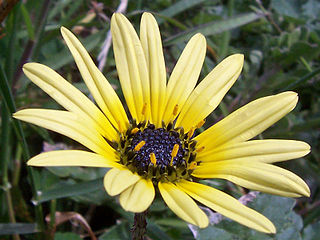
Arctotheca is a small genus of flowering plants in the family Asteraceae. They are annuals or perennials native to southern Africa. It is becoming an invasive weed in other parts of the world.
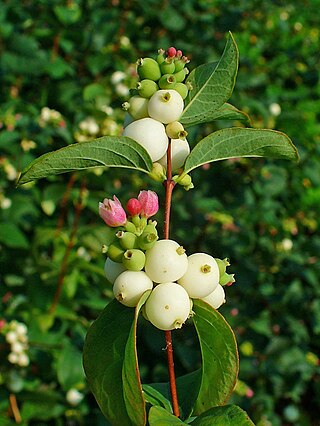
Symphoricarpos albus is a species of flowering plant in the honeysuckle family known by the common name common snowberry. Native to North America, it is browsed by some animals and planted for ornamental and ecological purposes, but is poisonous to humans.

Sagittaria platyphylla, the delta arrowhead, broad-leaf arrowhead or delta duck-potato, is a plant species native to the eastern United States.
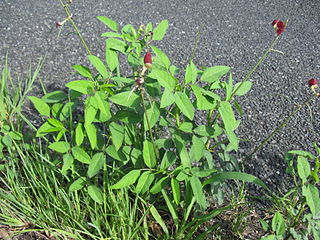
Macroptilium lathyroides is a species of plant in the legume family (Fabaceae) commonly known as the phasey bean. It is the type species of genus Macroptilium. Herbaceous annual or short-lived perennial growing up to 1 m high, it is native to the tropical and subtropical areas of Central and South America, and naturalized throughout the tropics. It is cultivated for forage or as a green manure or cover crop in rotation. As it quickly spreads on disturbed soils, it is considered an environmental weed in some areas.

An escaped plant is a cultivated plant that has escaped from agriculture, forestry or garden cultivation and has become naturalized in the wild. Usually not native to an area, escaped plants may become invasive. Therefore, escaped plants are the subject of research in invasion biology.



















